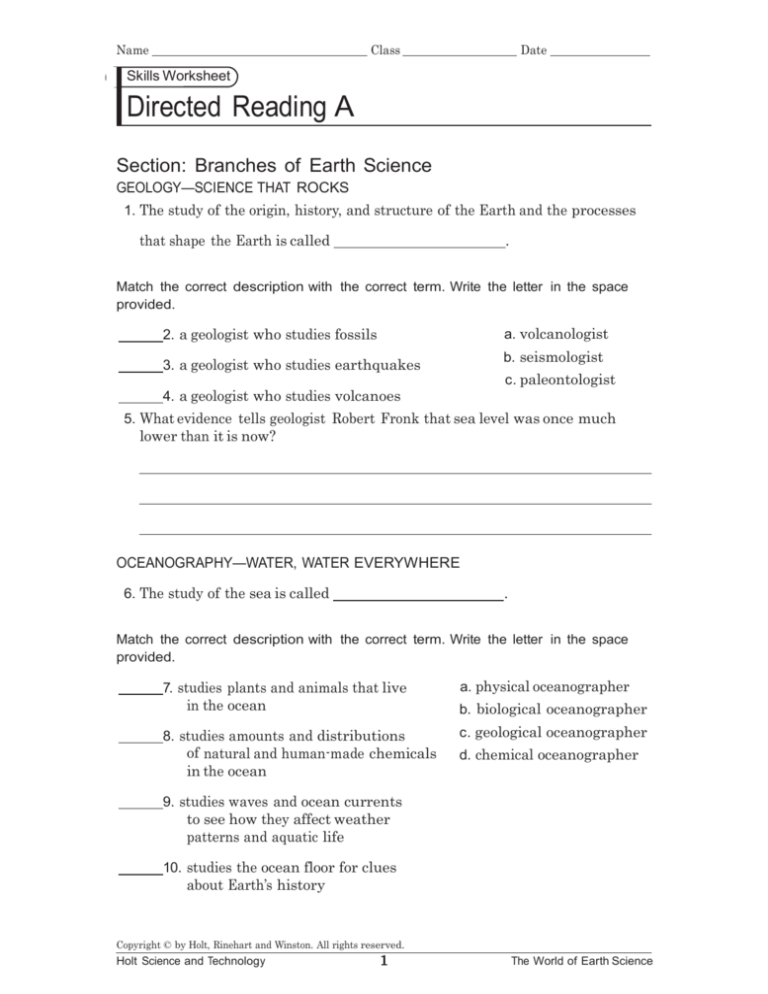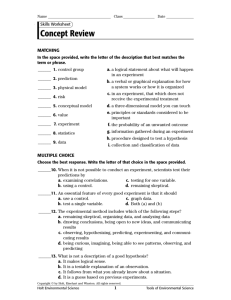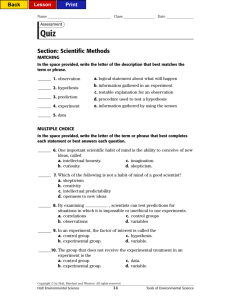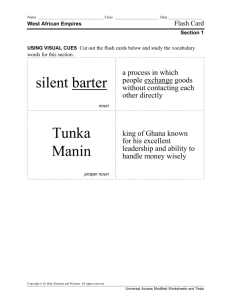
Name
Class
Date
Skills Worksheet
Directed Reading A
Section: Branches of Earth Science
GEOLOGY—SCIENCE THAT ROCKS
1. The study of the origin, history, and structure of the Earth and the processes
that shape the Earth is called
.
Match the correct description with the correct term. Write the letter in the space
provided.
a. volcanologist
2. a geologist who studies fossils
b. seismologist
3. a geologist who studies earthquakes
c. paleontologist
4. a geologist who studies volcanoes
5. What evidence tells geologist Robert Fronk that sea level was once much
lower than it is now?
OCEANOGRAPHY—WATER, WATER EVERYWHERE
6. The study of the sea is called
.
Match the correct description with the correct term. Write the letter in the space
provided.
7. studies plants and animals that live
in the ocean
8. studies amounts and distributions
of natural and human-made chemicals
in the ocean
a. physical oceanographer
b. biological oceanographer
c. geological oceanographer
d. chemical oceanographer
9. studies waves and ocean currents
to see how they affect weather
patterns and aquatic life
10. studies the ocean floor for clues
about Earth’s history
Copyright © by Holt, Rinehart and Winston. All rights reserved.
Holt Science and Technology
1
The World of Earth Science
Name
Class
Date
Directed Reading A continued
11. What technology do oceanographers use today to explore the ocean floor?
12. Rock chimneys are a type of hydrothermal vent on the ocean floor that spew
black clouds of minerals. They are called __________ ___________ .
13. How do hydrothermal vents support the biological community around them?
METEOROLOGY—IT’S A GAS!
14. The study of the Earth’s atmosphere and how it relates to weather and
climate is called
.
15. Why did fewer people die during Hurricane Andrew than during the similar
storm that hit Florida in 1928?
16. Why do meteorologists like Howard Bluestein chase tornadoes?
Copyright © by Holt, Rinehart and Winston. All rights reserved.
Holt Science and Technology
2
The World of Earth Science
Name
Class
Date
Directed Reading A continued
ASTRONOMY—FAR, FAR AWAY
17. Astronomy is the study of the
a. continents.
b. atmosphere.
c. universe.
d. Earth.
18. Some of the things that astronomers study include
a. bodies in space.
c. bacterial levels in water.
b. elements in fossils.
d. weather patterns on Earth.
19. What is one type of instrument that astronomers use?
a. a lensatic compass
c. a submarine periscope
b. an optical telescope
d. a submersible
20. What type of instrument do astronomers use to study objects that do
not give off light or that are very far away?
a. an astrolabe
c. a radio telescope
b. a stethoscope
d. an optical telescope
21. Astronomers can learn about bodies in space by studying the patterns
formed from
a. radio waves in space.
c. currents in oceans.
b. sound waves in space.
d. the sun’s rotation.
22. The star that is closest to the Earth is
a. Sirius.
c. the sun.
b. Orion.
d. the moon.
SPECIAL BRANCHES OF EARTH SCIENCE
23. The study of how humans interact with the environment is
called
.
24. What is one task of an environmental scientist?
25. On what other areas of science does environmental science rely?
26. A scientist who studies communities of organisms and their nonliving
environment is called a(n)
.
Copyright © by Holt, Rinehart and Winston. All rights reserved.
Holt Science and Technology
3
The World of Earth Science
27. In what other fields might an ecologist work?
28. Geochemistry combines the studies of what two areas of science?
29. Scientists who study the chemistry of rocks, minerals, and soil are
called
.
30. What things do geochemists try to determine?
31. Scientists who study the Earth’s surface features
are
.
32. Scientists who make maps of the Earth’s surface features are
called
.
33. What types of technology are used to make maps of the Earth’s features?
Copyright © by Holt, Rinehart and Winston. All rights reserved.
Holt Science and Technology
90
The World of Earth Science








